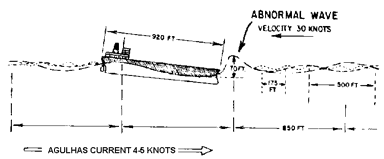 |
Science Frontiers ONLINE No. 66: Nov-Dec 1989 |
|
|
Rogue Waves
"Shortly before dawn on Sunday, June 3, 1984, the 117-foot, threemasted Marques sailed into a fierce squall about 75 miles north of Bermuda. Heavy rain began to pelt the ship, and a furious wind sprang up out of nowhere. Squalls were nothing new to the Marques, one of 39 tall ships participating in a transatlantic race. But as a precaution, Stuart Finlay, the seasoned 42-year-old American captain of the ship, shortened the sails. The Marques was carrying a crew of 28 - half of whom were under 25. At the helm, Philip Sefton, 22, fought the angry waves that now confronted them."Suddenly a heavy gust of wind pushed the Marques down on its starboard side. At the same instant 'a freakish wave of incredible force and size,' as Sefton later described it, slammed the ship broadside, pushing its masts farther beneath the surging water. A second wave pounded the ship as it went down. The Marques filled with water and sank in less than one minute. Most of the crew were trapped as they slept below deck. Only Sefton and eight shipmates survive."
Accounts such as that above are part of sea lore. Waves 50-100 feet high have been frequently reported over the years. Most often, they are encountered in rough seas, but some walls of water have smashed ships in relatively calm waters.
 A tanker encountering a steep-sided giant wave in the Aguhlas Current of the African coast. |
To illustrate, perhaps the most dangerous stretch of water in the world lies off southeast Africa, where the fast (8 feet/second) Agulhas Current often runs into storm waves surging up from Antarctica. The African continental shelf is so shaped that it funnels the current directly into the storm waves. Immense, steep-fronted waves have broken many a ship here.
In sum, the old statistical theory about the origin of rogue waves has been jettisoned, but a new approach is still in the formative stages. (Brown, Joseph; "Rogue Waves," Discover, 10:47, April 1989.)
Comment. But can any theory explain giant, solitary waves on calm seas. For more on this subject, see GHW in Earthquakes, Tides, Unidentified Sounds. To order this book, visit: here.